How to clean a washing machine from smell and dirt
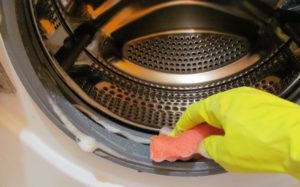 It’s easy to neglect your “home assistant” beyond recognition; it’s enough not to look after her for a couple of years. But how can you clean a washing machine from smell and dirt after such a disdainful attitude towards the rules of its operation? In this case, you will have to resort to a whole range of measures to give the washing machine its appearance. But first things first.
It’s easy to neglect your “home assistant” beyond recognition; it’s enough not to look after her for a couple of years. But how can you clean a washing machine from smell and dirt after such a disdainful attitude towards the rules of its operation? In this case, you will have to resort to a whole range of measures to give the washing machine its appearance. But first things first.
Physical cleaning
If the machine is running in such a way that dirt is visible in it and there is a stench, then one dry wash will not do. Dirt cannot be washed out this way. You will have to work hard with your hands, but first unplug the machine. The following parts of the washing machine can be washed by hand:
- rubber cuff;
- drum;
- drain hose and pipes;
- machine body;
- filter;
- powder cuvette;
- a heating element.
The easiest place to start is with the drain filter located at the bottom of the machine. It is hidden behind the bottom panel, which is held on by latches; some models have a door. After unscrewing the filter counterclockwise, take it out and wash it with any detergent, remove dirt and debris.
Do not forget to place rags near the machine, as water will flow from the hole under the filter.
Also look into the “socket” under the filter, there may also be debris there. When finished, wipe the parts with a dry cloth and return the filter to its place. This procedure is carried out at least once every three months.
Next you can work on the cuff. To clean it, you will need a solution of copper sulfate; you can also take diluted Domestos. Rub the gum with one of these products and then rinse with warm water.If the dirt is too ingrained, then try rubbing the seal with soda and leaving it for a while, then rub it with a soft sponge, rinse everything and wipe it dry. After this procedure, you will not only get rid of dirt, but also mold and musty smell. To prevent this from happening in the future, ventilate the drum after washing and wipe the cuff.
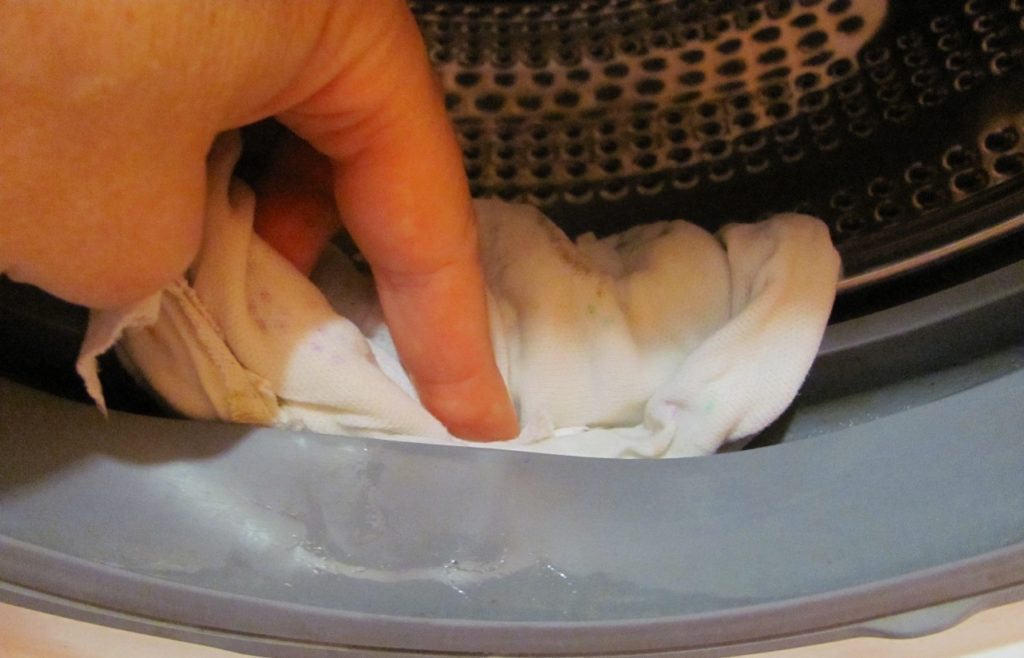
It is enough to simply clean the body of the automatic machine from dirt. You need to wipe it with a damp cloth and then with a dry one. Contaminated areas can be washed using a soap solution. The glass drum door can be cleaned by spraying it with glass cleaner. The powder cuvette is washed separately. Take it out of the washing machine body and soak it in a soap solution or citric acid solution, which will remove rusty deposits well. After soaking, rub the cuvette with a sponge or an old toothbrush, rinse and wipe dry.
The area under the cuvette is also thoroughly cleaned with a toothbrush; soda is used to clean old dirt.
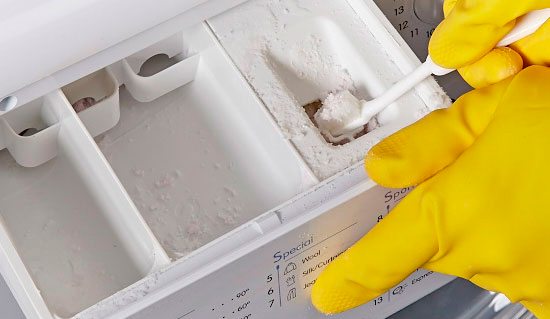
The process of cleaning hoses and pipes is complicated by the fact that they need to be disconnected from the washing machine. We described how to do this procedure in the article DIY hose cleaning.
Automatic cleaning with improvised means
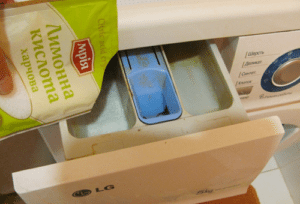 After manual cleaning of the washing machine, you need to start automatic cleaning. To do this, you will need 200 grams of baking soda or one glass of white vinegar. They are placed in a cuvette or directly in a drum and the washing mode is turned on when the water is heated to 60 degrees. This procedure will allow you to wash the inside of the machine from odors, mold and other contaminants.
After manual cleaning of the washing machine, you need to start automatic cleaning. To do this, you will need 200 grams of baking soda or one glass of white vinegar. They are placed in a cuvette or directly in a drum and the washing mode is turned on when the water is heated to 60 degrees. This procedure will allow you to wash the inside of the machine from odors, mold and other contaminants.
If there is a need to rid your equipment of the resulting limescale and scale deposits, then take a couple of large packs of lemon juice, about 100-150 grams. Pour the powder into the receptacle and turn on the longest mode at 900C, don't forget to set the extra rinse. Upon completion of the procedure, be sure to wipe the drum and large elastic band (cuff) so that no moisture remains on it. Pieces of scale may get stuck in the rubber band.
It is recommended to descale the appliance once every 6 months using citric acid. But everything will depend on the hardness of the water, the frequently used modes and the frequency of operation of the washing machine.
What chemicals to use for cleaning
With the difficulty of how to clean a washing machine from odors and dirt, chemical cleaning products will help you figure it out. There are a lot of them in stores and on the Internet. The first thing that comes to the mind of any housewife is “Whiteness”. Indeed, it is a cheap and effective remedy in the fight against mold, germs, as well as mildew and gasoline odors. However, it must be used with caution. After all, chlorine can damage the metal and rubber parts of the washing machine.
Before use, you need to clarify what the manufacturer of your “home assistant” writes about the use of bleach. If it is not prohibited, then try it, but again be careful. Pour no more than a glass of bleach into the powder receptacle and select the wash mode at 40-450WITH. Run the rinse twice, and when finished, ventilate the drum and room well.
Of the factory products for the washing machine, you can use:
- powder from Miele - cleaning powder from a famous German company producing household appliances. This product will get rid of both odors and bacteria;
- Dr.Beckmann - a substance designed to remove scale from a washing machine, has disinfectant properties;
- Magic Power is an excellent powder designed to remove lime and scale from a washing machine;
- The Topperr cleaning agent, recommended by Bosch representatives, is suitable for cleaning all automatic washing machines. Copes well with scale;
- Luxus Professional is a Russian-made powder that is used for washing machines and dishwashers;
- Antiscale is a cheaper descaling powder, but it does its job no worse than the previous one;
- Sandokkaebi is a substance made in Korea and used to disinfect washing machines. If the question arises of how to clean the machine from dirt, then this product must be used to remove all the bacteria accumulated inside the equipment.
This is just the top of the entire list of such tools. How to clean your washing machine with them is described in the instructions on the label. Be sure to read it before use.
Whatever you use to clean your machine, try not to start it. Monitor its condition and wash it regularly, both outside and inside. Happy general cleaning!
Interesting:
2 reader comments

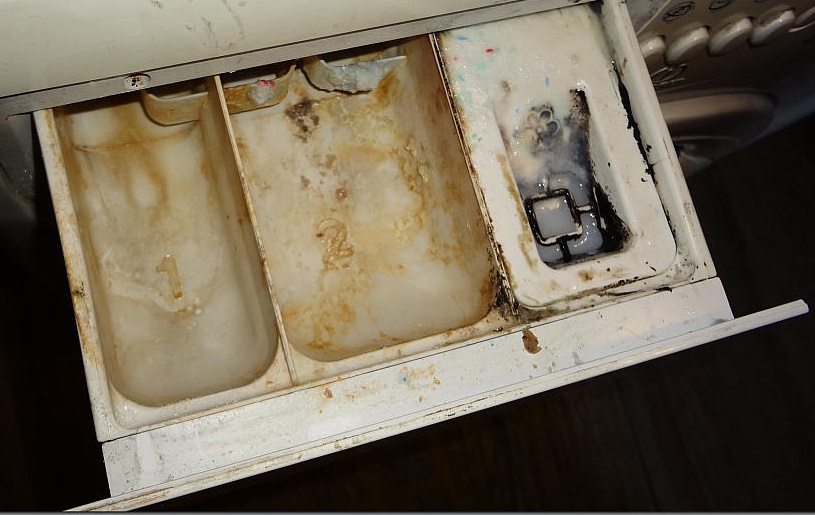
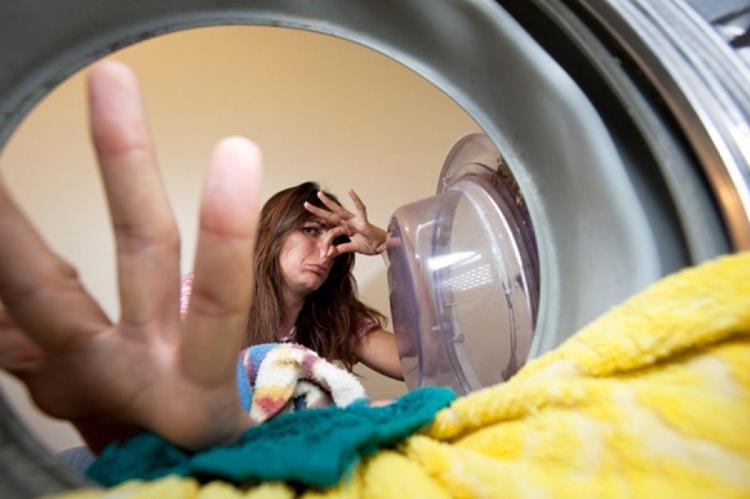


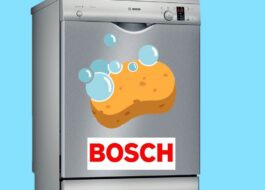















Should I add citric acid to clean my washing machine? For what? To get acquainted as quickly as possible with the repair and replacement of drum bearings and seals? At least strange advice for this resource :)
Try Adorgan-professional, it personally helps me effectively.